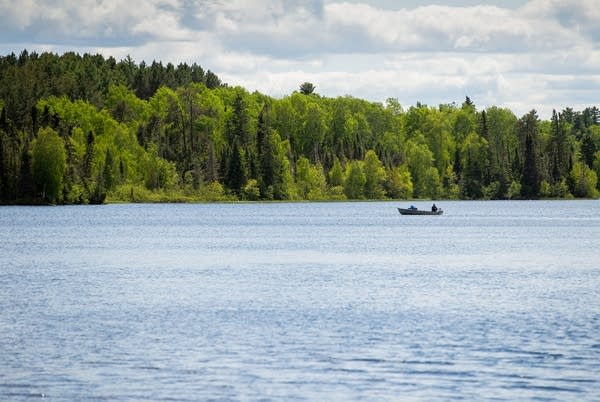State officials add dozens of lakes and streams to impaired waters list for sulfate and PFAS pollution

Go Deeper.
Create an account or log in to save stories.
Like this?
Thanks for liking this story! We have added it to a list of your favorite stories.
State officials are proposing to add 54 lakes, rivers and streams to the list of Minnesota waters considered impaired because of pollution, including a large lake on the border of the Boundary Waters Canoe Area Wilderness.
Federal law requires the Minnesota Pollution Control Agency to update the state’s impaired waters list every two years. It includes lakes, rivers and streams that no longer meet water quality standards.
While the number of water bodies added to the list is far fewer than two years ago, when 305 water bodies were added, it also shows continued challenges, especially in confronting PFAS, or “forever chemicals,” and sulfate, which can harm wild rice.
“There is some considerable reduction and progress and restoration in protecting our water bodies,” said Leya Charles, impaired waters coordinator at the MPCA. “There are still challenges that remain with some of these new emerging concerns, but we are overall seeing some good key milestones achieved.”
Turn Up Your Support
MPR News helps you turn down the noise and build shared understanding. Turn up your support for this public resource and keep trusted journalism accessible to all.
The draft 2024 list includes nearly 200 new impairments for a variety of pollution issues, including nutrients that grow algae, mercury levels that lead to limits on fish consumption, sediment that clouds water and unhealthy conditions for fish and bugs.
That brings the total amount of listings for all years to nearly 2,800 water bodies, with more than 6,300 impairments. A single lake or stream can be listed for multiple reasons.
Sulfate a growing concern
The 2024 list includes 20 new lakes and streams that are impaired for sulfate, which is discharged from mines, wastewater treatment plants and other industry and is harmful to the growth of wild rice, an important cultural and economic resource to many people in Minnesota, particularly tribal nations.
Among those added this year is Birch Lake, a large lake near Ely, Minn., that flows into the Boundary Waters wilderness, which was found to exceed the state’s sulfate standard for waters where wild rice grows.
For the past four years, the environmental group Northeastern Minnesotans for Wilderness — founder of the Campaign to Save the Boundary Waters — has monitored the lake for sulfate pollution. The MPCA relied largely on that data when making the determination to add the lake to its impaired waters list.
The group found sulfate pollution is entering the lake through the Dunka River and a stream referred to as Unnamed Creek, which drain an area that includes Northshore Mining, a currently operating taconite mine, and a now-closed iron ore mining pit.
“It’s sort of a double-edged sword to acknowledge that a place is already impaired for a pollutant,” said Campaign to Save the Boundary Waters Executive Director Ingrid Lyons. “But at the same time, we have this opportunity to recognize and validate the fact that this pollution exists, to clean it up, and to prevent future pollution.”
Lyons said adding the lake to the impaired waters list would make it more difficult to permit and open a copper-nickel mine in the watershed.
Twin Metals has proposed opening a massive underground mine on the edge of Birch Lake. While the Biden administration blocked the company’s initial plan, Twin Metals recently received permission from the Minnesota DNR to conduct exploratory drilling on state and privately owned mineral leases along the southern edge of the lake.
“We’re grateful to the MPCA for making the right decision,” Lyons said.
Thirty-five water bodies that exceed the state’s wild rice sulfate standard were added to the impaired waters list for the first time in 2022, after the federal Environmental Protection Agency said the state erred by not including them.
‘Forever’ chemicals
Meanwhile, the MPCA also is proposing to list three more water bodies due to high levels of a forever chemical known as PFOS: Sargent and Miller creeks in Duluth, and Crystal Lake in Robbinsdale. That brings the total number of water bodies impaired for PFOS on the list to 26.
The PFOS pollution at both sites in Duluth is linked to the use of firefighting foam at Lake Superior College’s Emergency Response Training Center, and at the Duluth Air National Guard Base.
The MPCA’s Leya Charles said Crystal Lake’s addition to the list is also due to PFOS in firefighting foam.
“As far as we know, there was a house fire. And there was some firefighting foam that was used in that area,” Charles said.
Per- and polyfluoroalkyl substances (PFAS), commonly known as “forever chemicals,” are found in numerous consumer products, from non-stick cookware to clothing, and are increasingly found in water bodies throughout the state.
One type of PFAS, Perfluorooctane sulfonic acid (PFOS), can accumulate in fish and can potentially cause adverse health effects in humans who consume it.
Earlier this year Minnesota lawmakers adopted sweeping new regulations on the use of PFAS, including a ban on the non-essential use of the chemicals in products ranging from carpeting and cosmetics to dental floss and ski wax.
A public comment period is open through Jan. 12. The U-S Environmental Protection Agency must approve the final list. There area also five virtual meetings scheduled in December.
The state has until April 1, 2024 to submit the list to the U.S. EPA, which will make the final decision on approving it.



